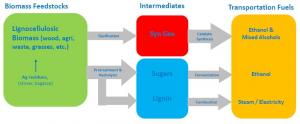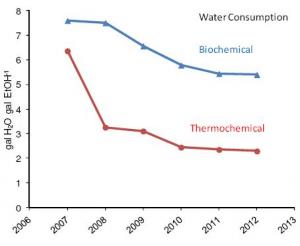
The National Renewable Energy Laboratory (NREL) is in the business of developing and evaluating biomass conversion technologies. One important aspect of these evaluations is assessing a process's level of sustainability, both now and what might be expected in the near future. Dr. Eric C. D. Tan of NREL presented the current state-of-technology (SOT) sustainability assessments for two conversion platforms: biochemical and thermochemical biomass conversion technologies.
The processes
The typical biochemical process for conversion of biomass to fuel involves a dilute acid pretreatment of the biomass prior to enzymatic hydrolysis of the cellulose to fermentable sugars. Lignins and other "non-fermentables" are usually consumed as fuel to create energy needed for the process. NREL has studied and reported on several processing routes. Corn stover (consists of the stalk, leaf, husk, and cob remaining in

the field following the harvest) is one of the target biomass sources and is often taken as the "baseline" cellulosic biomass for biofuels production via fermentation.
Many biomass sources are extremely complex and don't lend themselves as readily to the hydrolysis-fermentation route. For these feedstocks, a pyrolysis (thermal) process can be utilized to break down the complex celluloses and other organics to synthesis gases suitable for conversion to ethanol and other mixed alcohols (C3-C5) fuel stock. The biochemical route is specific to production of a particular molecule (usually ethanol) but is less efficient and feedstock sensitive. The thermochemical route is less specific (mixed alcohols) but is much less sensitive l to feedstock variations.
Sustainability factors
Yields calculated in ethanol equivalents are higher for thermochemical processing, ranging from the low to mid 90% range, versus the mid to upper 70% range for biochemical processing. However, the thermocheical process produces a mixed alcohol product (about 80% ethanol) versus a neat (100%) ethanol from the biochemical route.

Water use is an area with a wide variety of differing processes but it's also an area of recent significant improvement (reduction). Current dry-grind corn ethanol plants consume 3-4 gallons of water for each gallon of ethanol produced, compared to less than three for thermochemical processes and five to six for the biochemical route. Additional insight into water use in ethanol production can be found here.
Emissions from these plants consist primarily of CO2, NOx and SOx, and are generally higher for the biochemical process. The CO2 produced is actually not considered in greenhouse gas (GHG) calculations as it is considered biogenic, meaning it is consumed in the feedstock production phase and not considered in the IPCC global warming methodology.
GHG debits and credits are calculated on a per-gallon equivalency basis, with any energy created input as a credit to the "score." As might be expected from what has been discussed previously, the thermochemical process results in a lower (more sustainable) score than the biochemical process. Using the global warming potential (GWP) measure of kg CO2 per gallon of ethanol, the results for the 2011 SOT sustainability assessment are 0.5 and 3.2, respectively. The lion's share of difference comes not from the processes themselves, but the GWP factors of the feedstocks, which are seven times greater for corn stover as for the woody biomass feed of the thermochemical process.

Where to go from here
One of the more detailed evaluations underway involves the replacement of water cooling/cooling tower technology, where 90% of the water loss occurs, with air cooling systems. Although the capital costs increase significantly with air cooling, the variable operating costs are reduced, and the positive sustainability impact adds to the potential justification. NREL staff are also evaluating various cellulosic process options, including a previously reported split feed stream process.


